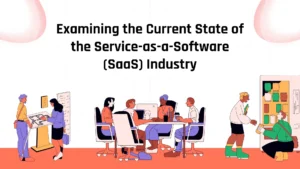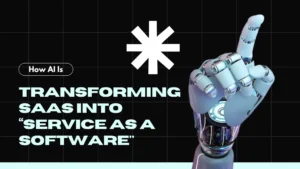Staying ahead of technological shifts is no longer optional—it’s essential. Businesses are constantly looking for innovative ways to deliver value, stay agile, and cater to ever-evolving customer expectations. As software solutions continue to evolve, a new trend is emerging known as SaaS to Service as a Software, promising greater customisation and flexibility. Curious about what’s next in the software world? Let’s dive into a concept that’s making waves: Service as a Software.
Introduction – The Emergence of Service as a Software (SaaS 2.0): A New Era in Technology
The technological landscape is constantly evolving, and SaaS (Software as a Service) has long been a cornerstone of software delivery. But what if the limitations of SaaS are giving rise to something more versatile? Enter Service as a Software—a paradigm shift designed to cater to increasingly dynamic and customised business needs. Is your business ready for this change? Let’s uncover the potential of SaaS 2.0.

What Is Service as a Software? Breaking Down the Concept
Service as a Software is not just a buzzword but a reinvention of how software services are provided and consumed. It focuses on breaking down large, monolithic applications into smaller, modular services that can be easily configured and adapted to specific business requirements.
Here’s what makes Service as a Software unique:
- Customization: Businesses can select and tailor only the modules they need, avoiding unnecessary features.
- Adaptability: Unlike fixed SaaS models, these services evolve dynamically.
- Ease of Integration: Modular services connect effortlessly with existing systems, ensuring seamless workflows.
By allowing businesses to build solutions piece by piece, Service as a Software ensures precision in meeting specific goals.
Key Differences Between SaaS and Service as a Software
While SaaS transformed software delivery, Service as a Software takes it to the next level by focusing on modularity and personalization. The critical differences are:

These distinctions highlight why SaaS 2.0 is an essential evolution for companies aiming to stay agile and competitive.
Advancements in Technology Enabling Service as a Software
The rise of Service as a Software isn’t just a natural progression—it’s fuelled by key technological innovations that make it possible. As businesses demand greater flexibility and efficiency, advancements in technology have laid the foundation for SaaS 2.0. Here are the driving forces behind this shift:
- Artificial Intelligence and Machine Learning:
These technologies allow real-time personalization, adapting services based on user needs and preferences. - Cloud Computing Infrastructure:
Modern cloud platforms support scalable and decentralised architectures, making modular services viable. - API-Driven Ecosystems:
APIs (Application Programming Interfaces) enable seamless integration between different service modules, ensuring interoperability. - Microservices Architecture:
Lightweight, independent components are key to modular systems, allowing flexibility in scaling and development.
These advancements collectively push the boundaries of what software delivery can achieve.
Benefits of Transitioning to Service as a Software
The shift to Service as a Software offers numerous advantages for both businesses and end-users. While traditional SaaS models brought scalability and accessibility, Service as a Software adds layers of customization, efficiency, and adaptability that were previously unattainable.
Benefits Include:
- Tailored Solutions: Businesses can design tools specific to their processes and goals.
- Cost Savings: Pay only for what is used, eliminating waste associated with pre-packaged applications.
- Scalability: Modular systems grow with your business without requiring complete overhauls.
- Enhanced User Experience: By focusing on personalization, end-users enjoy interfaces and functionalities tailored to their specific needs.
With these benefits, it’s easy to see why businesses are eager to embrace SaaS 2.0.
Potential Challenges and How to Overcome Them
Transitioning to any new model isn’t without its hurdles, and Service as a Software is no exception. However, the challenges can be addressed with strategic planning and proactive measures.

By addressing these issues head-on, businesses can ensure a smoother transition to SaaS 2.0.
Top Sectors Benefiting From the Transition
Certain industries are at the forefront of adopting Service as a Software, leveraging its potential to redefine their operations. Leading industries include:

- Healthcare:
- Personalized patient care through integrated scheduling, analytics, and telehealth services.
- Fintech:
- Modular tools for risk assessment, payment processing, and fraud detection enable agility in financial services.
- Retail:
- Platforms tailored for inventory management, customer insights, and dynamic pricing are transforming retail operations.
These industries demonstrate how SaaS 2.0 can create tailored solutions for complex needs.
Building the Right Tech Infrastructure for the Transition
Preparation is crucial to fully leverage the benefits of Service as a Software. Businesses must adapt their infrastructure and processes to align with this new model. Steps to prepare:
- Assess Business Needs:
Conduct a gap analysis to identify pain points that modular services can address. - Adopt Scalable Platforms:
Invest in cloud-based platforms that support modular architecture. - Upskill Your Workforce:
Equip employees with the knowledge and tools needed to navigate the new system. - Collaborate with Providers:
Choose service providers who offer flexibility, transparency, and robust support.
These steps ensure a smooth transition while maximising the benefits of SaaS 2.0.
Conclusion – Why the Future of Software Lies in Service as a Software
The evolution from SaaS to Service as a Software marks a significant step forward in how businesses interact with technology. It bridges the gap between standardisation and personalization, providing scalable, adaptable, and efficient solutions.
So, is your business ready for this transition? By addressing challenges and preparing strategically, you can position yourself at the forefront of this exciting technological revolution. After all, the future isn’t just about consuming software—it’s about designing the services that truly serve you.



